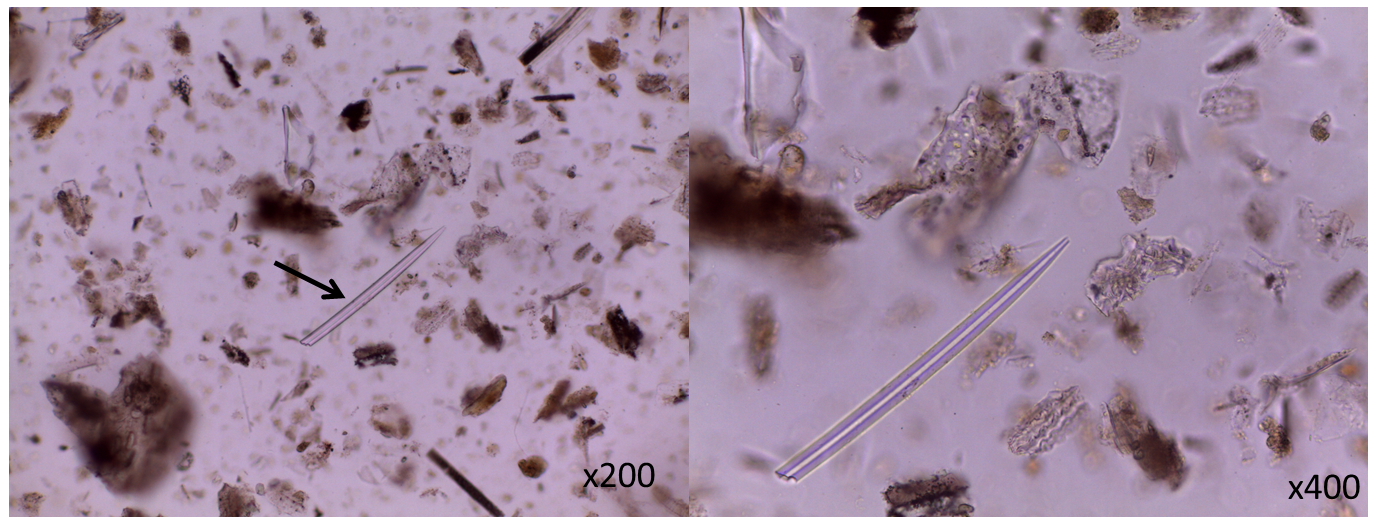Microfossil of the Month: Sponge Spicule
Something a little bit different - this month I have an image of a siliceous sponge spicule! This show up occasionally in my phytolith slides, and are very distinctive. Sponges, or poriferans to give them their scientific name, are characterised by an unusual feeding system that involves drawing water in through little pores in the outer walls, and filtering food from the water as it moves around their bodies, before being pumped back out again. This flow of water occurs in one direction and is driven by beating flagella. Sponge spicules provide structural support and protection from predators. They come in all sorts of shapes each with a different name - the single spike shape that you can see looks like a monaxon, though it is also possible that is has broken off a larger 'polyaxon' type.
The formation of spicules seems to be better understand than that of my other favourite siliceous microfossil, the phytolith, and is controlled largely genetically, but with environmental conditions (i.e. the amount of silica available in the environment) having an impact on whether a genetically determined spicule type is expressed. This example comes from the same ashy midden deposit as last month's reed phytoliths. If we can identify the genus or species that the spicule comes from then it may help understand where the reeds and other plants were coming from, or even the type of environment, and is also a good indicator of water pollution.
I am not an expert on them so cannot identify them definitely beyond a general category, though this example does appear similar to the 'megasclere' spicules of freshwater sponge Spongilia lacustris, or perhaps Ephydatia fluviatilis. If any readers have suggestions I would love to hear them! It makes sense that we have freshwater sponges given the location of the site that it is from, Boncuklu, would have been close to a range of wetland environments in the Neolithic. Knowing more about the species and the ecological requirements would be very interesting.
The formation of spicules seems to be better understand than that of my other favourite siliceous microfossil, the phytolith, and is controlled largely genetically, but with environmental conditions (i.e. the amount of silica available in the environment) having an impact on whether a genetically determined spicule type is expressed. This example comes from the same ashy midden deposit as last month's reed phytoliths. If we can identify the genus or species that the spicule comes from then it may help understand where the reeds and other plants were coming from, or even the type of environment, and is also a good indicator of water pollution.
I am not an expert on them so cannot identify them definitely beyond a general category, though this example does appear similar to the 'megasclere' spicules of freshwater sponge Spongilia lacustris, or perhaps Ephydatia fluviatilis. If any readers have suggestions I would love to hear them! It makes sense that we have freshwater sponges given the location of the site that it is from, Boncuklu, would have been close to a range of wetland environments in the Neolithic. Knowing more about the species and the ecological requirements would be very interesting.


Hi, I also got several sponges spicule in my slides. They look like yours. I was intrigued and asked to Renata Manconi (she is on Researchgate), a specialist based in Italy. She told me that they belong to the sub-order Spongillina, but more spicule are needed to get down to the genera. A paper you can have a look at:
ReplyDeleteManconi & Pronzato, 2002, Suborder Spongillina subord. nov. freshwater sponges In book: Systema Porifera. A Guide to the Classification of Sponges 1, Editors: J. N. A. Hooper, R. W. M. van Soest, pp.921-1019
Thank you for the reference, I'll look into it! Not many in this slide but others have quite a lot
Delete